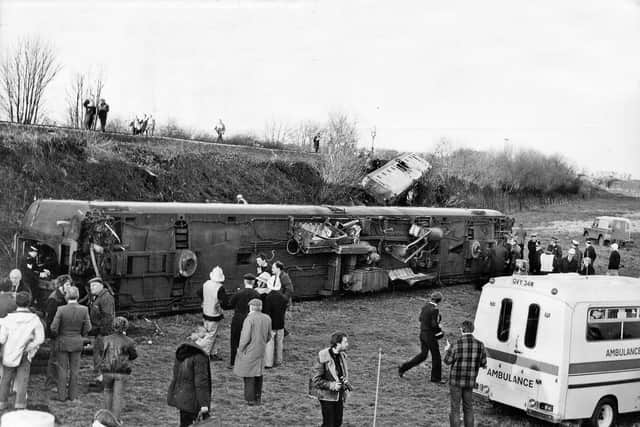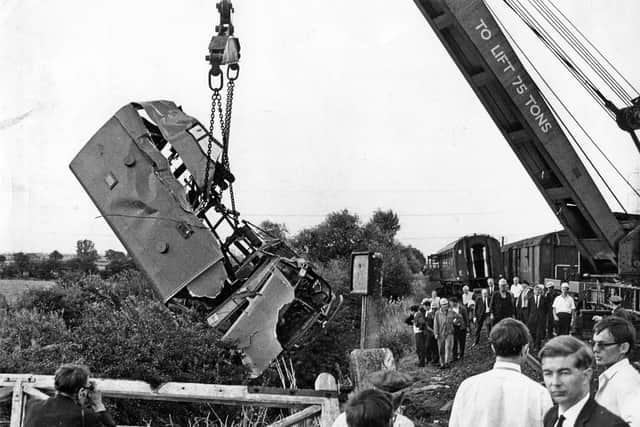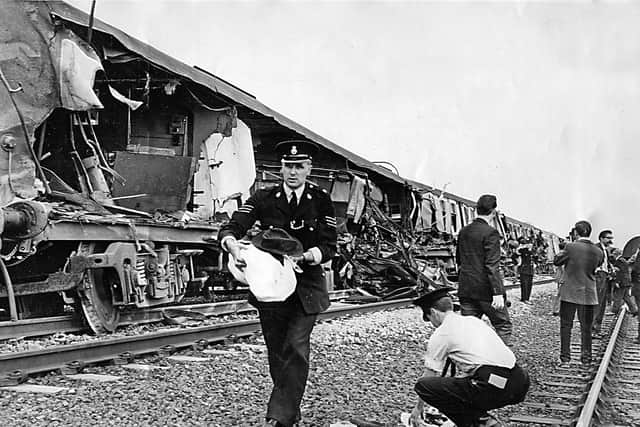Memory Lane: Remembering the disasters that brought death to Yorkshire's railways
The UK’s worst rail accident was at Quintinshill, in Scotland in 1915 with 226 dead and 246 injured. England recorded its worst disaster in 1952 with the Harrow and Wealdstone crash which killed 112 people and injured 340.
Yorkshire has seen some terrible railway accidents particularly on the main London to Scotland lines passing through the county.
Advertisement
Hide AdAdvertisement
Hide AdOn Thursday January 19, 1905, J. Mathieson, General Manager of the Midland Railway made a statement after a crash on the company’s system.


During the fog earlier that day, he said the southbound Scotch Express ran into the main train from Leeds a short distance south of Cudworth, blocking both main lines. There were seven fatalities and 18 injured.
The express train from London to Scotland was approaching at the time of the disaster, but the attention of the driver of the train was alerted by means of detonators placed on the rails. This averted a further collision. During the obstruction, through traffic was worked by an alternative route via Chapeltown.
Surprisingly, it was said the conduct of the passengers ‘was splendid. There was no panic.’ The rescue party had found a woman and her baby. They were in an adjoining field. The mother was bleeding, but the child was not hurt.
Advertisement
Hide AdAdvertisement
Hide AdThey had been travelling in a sleeping car at the time of the crash, but with the assistance of other passengers they were able to leave the compartment before it was reached by flames. Information on the railwaysarchive website states: ‘The primary cause of the accident was driver error; the secondary cause was inadequate fog protection.’


At 5.49 am on Saturday December 24, 1910, a crash occurred at Hawes junction. This was just north of Lunds viaduct on the Midland Railway’s Settle and Carlisle main line. Involved was the Midland’s night express from St Pancras to Glasgow, which had left Leeds at 4.00 am.
It resulted in 12 deaths and 17 passengers injured. The bodies of the dead were taken to the nearby Moorcock Inn. Among the passengers were a young couple travelling from Hampshire to Glasgow with a baby a few months old. The father and mother escaped with their lives, but the baby was killed.
The disaster was caused by the express, travelling at 65mph, colliding with two light engines returning to Carlise. Their presence on the line had been overlooked by a signalman. From the earliest days of public railways in the UK, railway accidents were investigated by Her Majesty’s Railway Inspectorate – an independent body.
Advertisement
Hide AdAdvertisement
Hide AdMajor John Wallace Pringle was the investigating officer at Hawes. He judged that the signalman, who admitted his mistake, was the primary cause of the accident, though criticised the two light engine drivers for not observing certain procedures.


The driver of the pilot engine of the wrecked express told a Leeds Mercury reporter: ‘I stood on my engine until it came to a dead stand. I should think we travelled 150 yards after colliding. We were off the line, and I was all the time expecting we should go down the embankment, being in a cutting. Happily, we rested on the bank.’
Near Thirsk on July 31, 1967, the 12.00 pm King’s Cross to Edinburgh express travelling at 80mph collided with a 35-ton cement wagon on the down fast line.
The wagon had become detached from the partially derailed Cliff to Uddington cement train. It had BR Class 40 D283 at the helm and was travelling on the down slow line.
Advertisement
Hide AdAdvertisement
Hide AdTragically, seven people were killed in the accident and forty-five were injured; the driver and second man of the express escaped serious injury. Locomotive DP2 at the head of the express was an English Electric Type Four prototype. It was built at Vulcan Foundry in 1962 and was withdrawn as a result of the collision.
The derailment of the cement wagon was blamed on worn suspension and caused it to jump off the track. Subsequently, new speed restrictions were placed on wagons. Work to clear the track continued through the night.
For a time, northbound trains from York were diverted via Ripon and were subject to delays of around 45 minutes. A 48-year-old woman, Isabella Mary Smart Reid of Kirkella, who was both a doctor and a Hull magistrate was one of the seven people killed. Other Hull passengers on the express included a honeymoon couple and a 64-year-old railwayman – himself the driver of a train involved in a one-coach derailment 10 years earlier.
Only two days after their marriage, the honeymoon couple, Mr and Mrs Peckett, had caught the express at Selby. They were due to change at Darlington for a short stay at Hartlepool. Mrs Peckett was flung across a crowded compartment on the train. Her husband had cuts and bruises. Both continued their journey after the crash.
Advertisement
Hide AdAdvertisement
Hide AdOne man was killed and seven injured when the van in which they were travelling was struck by a train on an unmanned level crossing in Alexandra Street, Thorne, on July 25, 1969.
The train was the 4.26 pm Doncaster to Hull Diesel Multiple Unit carrying about 250 passengers. The accident occurred at 4.45 pm. The van was carried about 20 yards down the track and tossed into a ditch. Owned by William Press Ltd of Bawtry, the vehicle was carrying their workmen who had been engaged on a natural gas conversion job.
The crossing, known as Lands End Road crossing, had witnessed two fatal accidents in the previous two years. The driver of the train was treated for head injuries and shock. None of the train passengers were injured.
They continued their journey by bus while rail staff began clearing the track and putting the train’s front pair of wheels back on the line.
Advertisement
Hide AdAdvertisement
Hide AdEighty passengers had a lucky escape on December 8, 1981 when the InterCity 13.50 pm York to Liverpool service left the track at 70 mph. Two carriages ended up on their sides, one in a field and the other halfway down a 15ft embankment at Ulleskelf near Tadcaster.
Twenty-two people needed hospital treatment at York. A 55-yearold man from Leeds was seriously hurt in the accident.
The first man on the scene, John Wilkinson (53) of Ulleskelf said: ‘It is a miracle many of them were not killed. When I got here a couple of women were walking about the field and others seemed to be dazed. No one appeared to have realised what had happened.’ Wilkinson and other helpers scrambled into one of the carriages.
He added: ‘All the passengers were brilliant. We never heard any screaming or crying. One woman with a baby appeared to heave a broken collar bone.’
Advertisement
Hide AdAdvertisement
Hide AdThe rail disaster at Great Heck, Selby occurred at approximately 06.13 am on February 28, 2001. A Land Rover Defender towing a loaded trailer (carrying a Renault Savanna estate car) swerved off the M62 motorway just before a bridge over the East Coast Main Line.
The vehicle ran down an embankment on to the southbound railway track. It was hit by a southbound GNER InterCity 225 heading from Newcastle to King’s Cross at over 120 mph. After striking the Land Rover, the leading bogie of the Driving Van Trailer (DVT) derailed but the train stayed upright.
However, points to nearby sidings deflected it into the path of an oncoming Freightliner train, running 20 minutes early and travelling from Immingham to Ferrybridge hauled by a Class 66 locomotive (no. 66521).
The two trains collided approximately half a mile from the impact with the Land Rover. No. 66521 overturned on to its left side and the first nine wagons were derailed and damaged. Both train drivers, two additional train crew on board the 225 and six passengers were killed.
Eighty-two people suffered serious injuries.
Advertisement
Hide AdAdvertisement
Hide AdOne newspaper report said: ‘This 21st-century disaster was summed up by one eerie detail. Rescue workers combing through the wreckage continually heard mobile phones ringing from inside the tangled metal.’
Comment Guidelines
National World encourages reader discussion on our stories. User feedback, insights and back-and-forth exchanges add a rich layer of context to reporting. Please review our Community Guidelines before commenting.